The AMD A8-7670K APU Review: Aiming for Rocket League
by Ian Cutress on November 18, 2015 8:00 AM ESTGaming Benchmarks: Low End
To satisfy our curiosity regarding low-power gaming, as well as dual graphics arrangements, we ran our regular suite through each processor. On this page are our integrated graphics results, along with a cheaper graphics solution in the R7 240 DDR3 and, in the case of AMD, both of these together in dual graphics mode.
Alien: Isolation
If first-person survival mixed with horror is your sort of thing, then Alien: Isolation, based off of the Alien franchise, should be an interesting title. Developed by Creative Assembly and released in October 2014, Alien: Isolation has won numerous awards, ranging from Game Of The Year to several top 10s/25s and Best Horror titles, ratcheting up over a million sales by February 2015. Alien: Isolation uses a custom-built engine that includes dynamic sound effects and should be fully multicore enabled.
For low-end graphics, we test at 720p with Ultra settings, whereas for mid- and high-range graphics, we bump this up to 1080p, taking the average frame rate as our marker with a scripted version of the built-in benchmark.

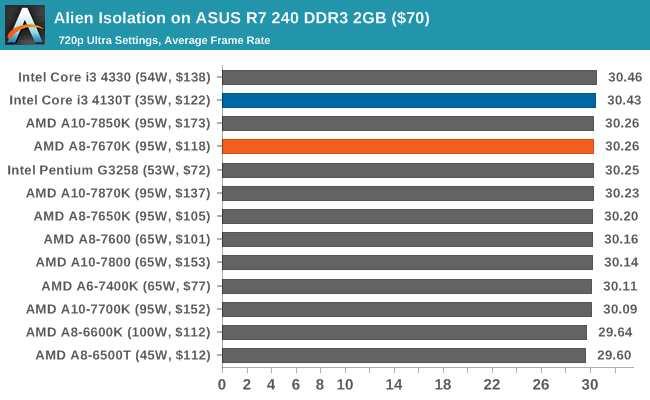
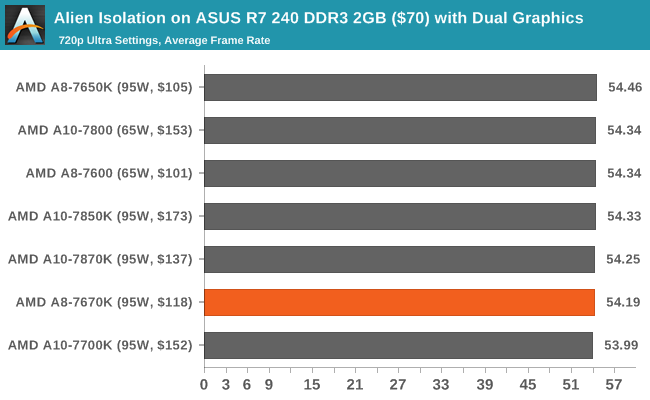
Total War: Attila
The Total War franchise moves on to Attila, another Creative Assembly development, and is a stand-alone strategy title set in 395AD where the main story line lets the gamer take control of the leader of the Huns in order to conquer parts of the world. Graphically, the game can render hundreds/thousands of units on-screen at once, all with their individual actions, and can put some of the big cards to task.
For low-end graphics, we test at 720p with performance settings, recording the average frame rate. With mid- and high-range graphics, we test at 1080p with the quality setting. In both circumstances, unlimited video memory is enabled, and the in-game scripted benchmark is used.
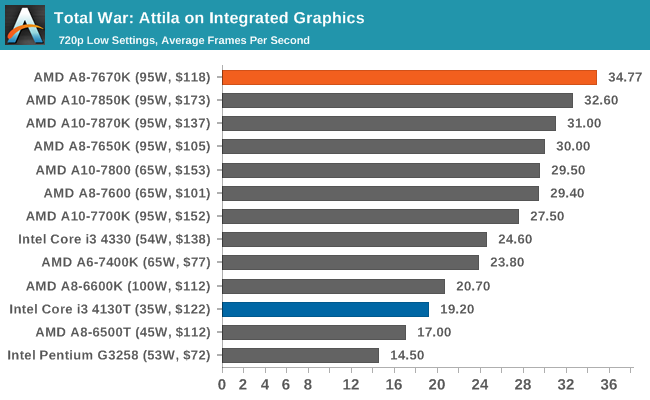

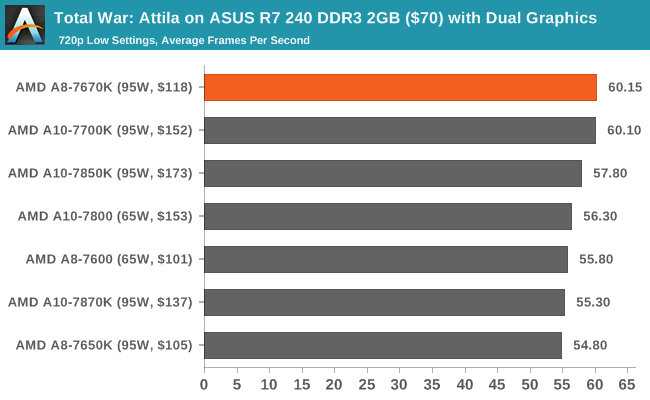
Grand Theft Auto V
The highly anticipated iteration of the Grand Theft Auto franchise finally hit the shelves on April 14, 2015, with both AMD and NVIDIA in tow to help optimize the title. GTA doesn’t provide graphical presets, but it opens up the options to users and extends the boundaries by pushing even the hardest systems to the limit using Rockstar’s Advanced Game Engine. Whether the user is flying high in the mountains with long draw distances or dealing with assorted trash in the city, when cranked up to maximum, it creates stunning visuals but hard work for both the CPU and the GPU.
For our test, we have scripted a version of the in-game benchmark, relying only on the final part, which combines a flight scene with an in-city drive-by, followed by a tanker explosion. For low-end systems, we test at 720p on the lowest settings, whereas mid- and high-end graphics play at 1080p with very high settings across the board. We record both the average frame rate and the percentage of frames under 60 fps (16.6 ms).

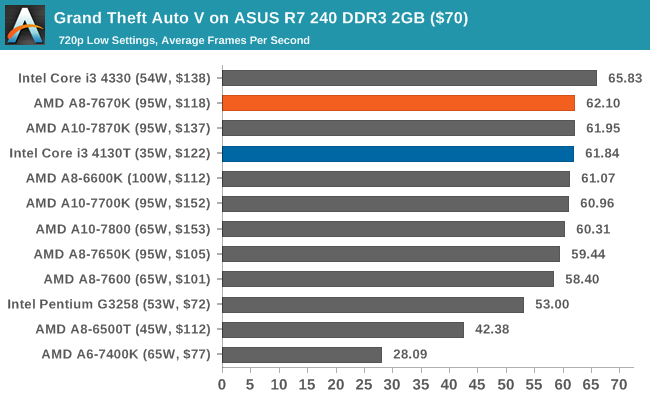
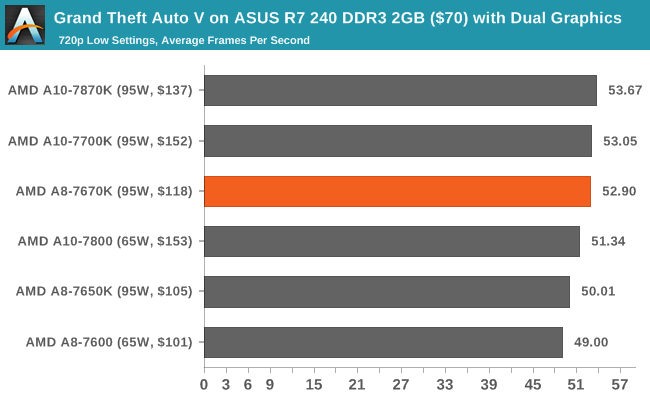
GRID: Autosport
No graphics test is complete without some input from Codemasters and the Ego engine, which means for this round of testing, we point toward GRID: Autosport, the next iteration in the GRID and racing genre. As with our previous racing testing, each update to the engine aims to add in effects, reflections, detail and realism, with Codemasters making "authenticity" a main focal point for this version.
GRID’s benchmark mode is very flexible, and as a result, we created a test race using a shortened version of the Red Bull Ring with 12 cars doing two laps. The player car is in focus throughout this benchmark and starts last, but usually finishes second or third. For low-end graphics, we test at 1080p and medium settings, whereas mid- and high-end graphics get the full 1080p maximum. Both the average and the minimum frame rates are recorded.
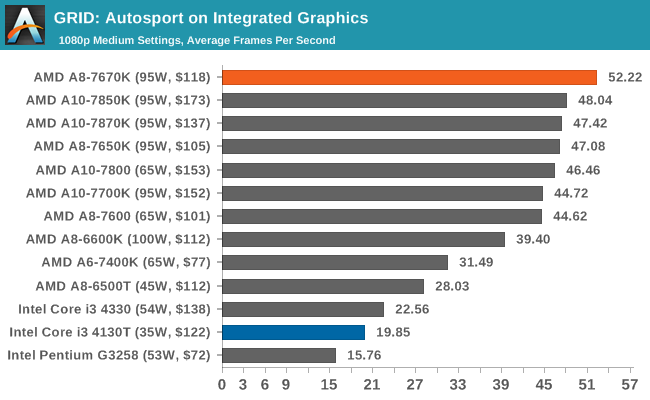
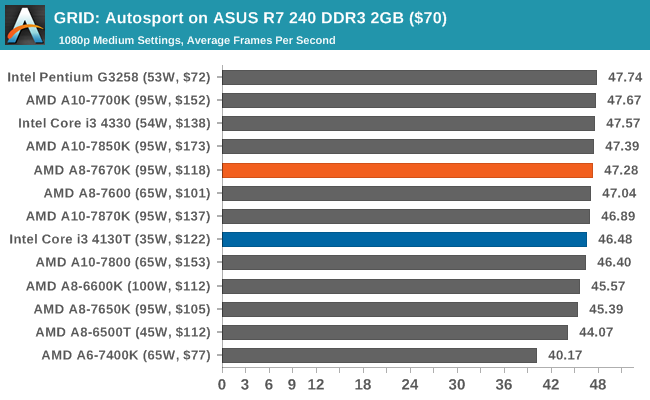
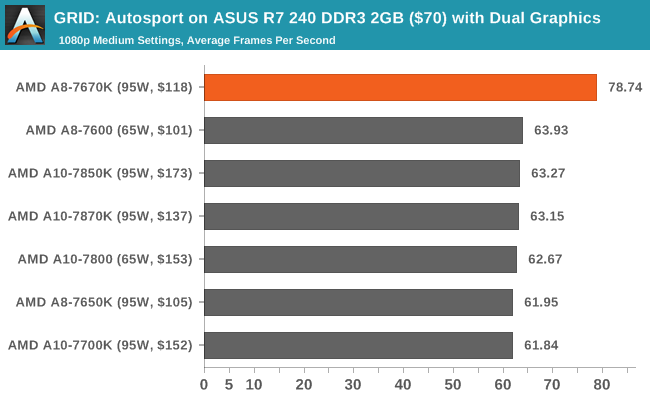
For whatever reason, the A8-7670K gets a good showing in the integrated tests, especially in dual graphics mode, with an abnormally high score. Some other issue might be at play here and warrants further testing.
Middle-Earth: Shadows of Mordor
The final title in our testing is another battle of system performance with the open-world action-adventure title Shadow of Mordor. Produced by Monolith using the LithTech Jupiter EX engine and numerous detail add-ons, SoM goes for detail and complexity to a large extent, despite having to be cut down from the original plans. The main story was written by the same writer as Red Dead Redemption, and it received Zero Punctuation’s Game of The Year in 2014.
For testing purposes, SoM gives a dynamic screen resolution setting, allowing us to render at high resolutions that are then scaled down to the monitor. As a result, we get several tests using the in-game benchmark. For low-end graphics, we examine at 720p with low settings, whereas mid- and high-end graphics get 1080p Ultra. The top graphics test is also redone at 3840x2160, also with Ultra settings, and we also test two cards at 4K where possible.
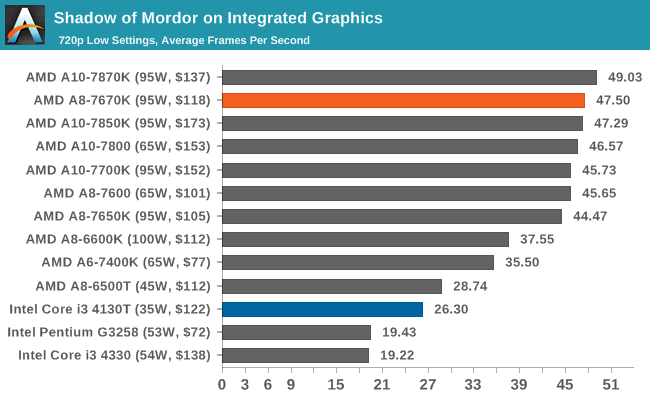
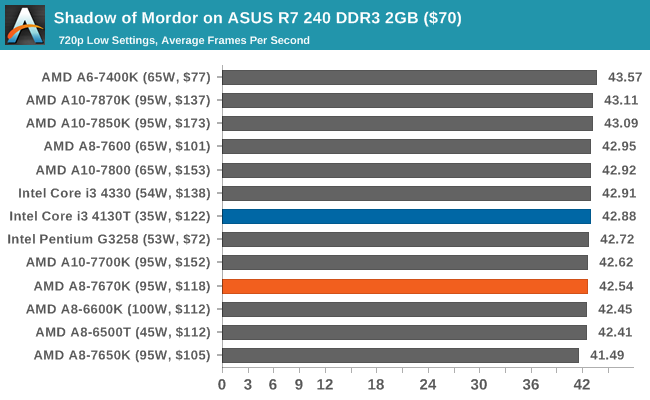
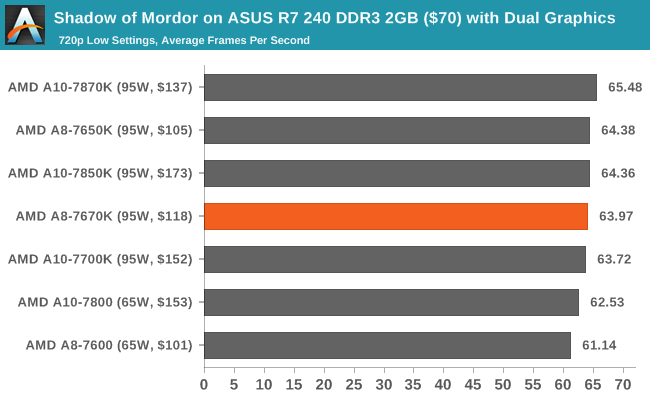















154 Comments
View All Comments
BurntMyBacon - Thursday, November 19, 2015 - link
@Ian Cutress: "It's never an issue of lack of interest or subversion, just procurement (and ensuring we can communicate with the manufacturer at the point of testing)."[sarcasm]I thought Intel and all other computer hardware manufacturers were required by LAW to send their products to Anandtech for prelaunch approval where Supreme Tech Justice Cutress and his colleagues pronounce life or death on potential products. ;' ) [/sarcasm]
Seriously though, I'd say you are doing fine despite the real world procurement and scheduling issues getting in the way.
flabber - Wednesday, November 18, 2015 - link
I can't agree any more with the point that power consumption is the least of my concerns. While there is a significant difference between a 250W TDP CPU and a 50W TDP CPU, where one would have to factor in the cost of cooling and a PSU, 100W is quite manageable. A 500W PSU is more that adequate for just about any current system. However, I am aware that decreased power consumption is an objective in all consumer products and will be seeing in upcoming computer components. (Ironically for mobile components, my 2009 Blackberry with a 1150mAh battery can still run for a couple days before I need charge it.)My rig is equipped with a A10-5800k (2012) and a year old R9-290X (2013). Everyday tasks, such as using a spreadsheet, word processor, citation management or occasional image editing, can't be improved in any noticeably way. With regard to gaming, I can't be bothered to upgrade the motherboard and CPU to a superior Intel alternative. A few more frames per second won't make a game with poor storyline any better, nor will an enjoyable game become any better.
Pissedoffyouth - Thursday, November 19, 2015 - link
If you have 5800 you should look at getting a kaveri for better performance and lower power consumptionGadgety - Thursday, November 19, 2015 - link
"AMD's first talking point is, of course, price. AMD considers their processors very price-competitive"No kidding, I got the A8-7600 for my kid and it's integrated graphics is comparable to the i7 Iris Pro, where the i7 is 5x more expensive. So for 20% of the price we get to enjoy graphics galore. Put it on Asrock's A88X M-ITX motherboard and it outputs 4K cinema. No graphics card means it's compact so we use a tiny chassis, perfect HTPC, and useable for the type of light gaming the kids do.
Gadgety - Thursday, November 19, 2015 - link
@Ian Cutress The performance parity, and sometimes superiority, of the A8-7670k compared to the A10-7850k, and also to the A10-7870k, I guess could be attributable to driver improvements. Did you use the same drivers, or updated versions? If it's improved drivers, this would likely also improve across the APU-range.Ian Cutress - Thursday, November 19, 2015 - link
Same drivers for each. I lock a set of drivers down every test-bed refresh, so in this case it would be 15.4 beta, which is getting a bit old now. Kaveri Refresh does have some minor internal improvements as well I imagine, internal bus frequencies perhaps. There's always a small amount of volatility in the benchmark, depending on what heat density or board issue you might have. Looking back, we haven't always used the same motherboard on the APUs just due to timing (but all A88X), and even though we do some overriding on power profiles it can be difficult to compensate for motherboard manufacturer non-user exposed firmware optimisations on the memory buses.Come the next year test-bed refresh (with DX12 relevant titles hopefully), I'll be going back and redoing them all. That should clear out the cobwebs on the latest drivers and updates, providing a new base.
milli - Thursday, November 19, 2015 - link
Ian Cutress, how is the review of your grandparents laptop coming along? :)I'm waiting for that Carrizo review.
zlandar - Thursday, November 19, 2015 - link
I don't see the point of being so cheap that you are unwilling to spend more for a superior i3-5 and discrete video card. Why would you chain yourself to a dead-end cpu/gpu integrated combo and motherboard that isn't very good to start with?Plenty of people have pointed out how well Intel's cpu have held up since Sandy Bridge. I'm still using a 2600k and have upgraded my video card 3 times. If you are on a tight gaming budget it makes alot more sense to buy 2nd-3rd tier last gen video cards coupled with a good cpu you don't need to upgrade.
BurntMyBacon - Thursday, November 19, 2015 - link
@zlandar "Why would you chain yourself to a dead-end cpu/gpu integrated combo and motherboard that isn't very good to start with?"Aren't just about all laptops deadend with respect to CPU/GPU? (Particularly in the Carrizo price range)
Ton's of laptops are sold without discrete GPUs and no option to upgrade. Why should this matter to a Carrizo review (clearly laptop in this request)?
Ian Cutress - Thursday, November 19, 2015 - link
Something special in the works. After SC15 finishes, I'll be digesting the mountain of data I have. :)